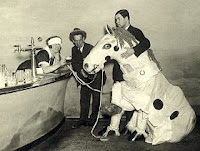 It used to be said that man is the animal that laughs, or the tool making animal, or the political animal. Mark Twain said “Man is the only animal that blushes -- or needs to.” But I'm convinced that man is the animal that makes believe.
It used to be said that man is the animal that laughs, or the tool making animal, or the political animal. Mark Twain said “Man is the only animal that blushes -- or needs to.” But I'm convinced that man is the animal that makes believe.[Image - famed publicist Jim Moran with an early beer-loving horsie that traveled from bar to California bar in the 20s]
When I was a small child, just like you did I am sure, I would pretend to be a horse running around the living room, or a groundhog living in my tunnel of quilts and pillows, or a bird sitting on the edge of a branch. I think it is probably impossible to stop children from pretending to be all these things. I am certain that it would be a bad idea.
Human beings succeed not because of their physical strength or any special skill -- they are pretty helpless animals, when you come right down to it, with little in the way of armor or claws or teeth.
Human beings succeed, I believe, because of their amazing skill at imitation.
§ Part of this is imitating each other, and thus learning skills and passed down through generations by way of stories and textbooks.Is it useful to be such imitative fools, constantly trying on the skins of other creatures? It is essential. No human being is a match for a wildebeest, but a group of humans can gain functional equivalence to a pride of lions – stalking and driving the herd, and taking the animal down with claws at a distance (spears) and claws up close (knives). They don't look like lions, but they are functional equivalents.
§ Part of it is imitating other creatures – horsies, birds, fish, trees. Is there a child who doesn’t know what you mean when you say, “Can you be a tree now?”
§ Finally, part of this is imitating things they have never seen, or which may not even exist.
Hercules wore the skin of the Nemean Lion, and it symbolized his strength, but I bet it slowed him down. Functional equivalence is achieved by copying the functional aspects of the model, not the outward appearance. Humans imitate best when they imitate the behaviour patterns of other species, and make their physical attributes into tools that do what the lion’s claws and teeth, or the cow’s complex stomachs, or the mole’s strong forelegs and digging claws achieve.
Over time, I will discuss some of these imitations as economic models – among them the Cactus model, the Scorpion model, the Meerkat model or the Hyena model. But today I will begin by discussing the Pantomime Horse.
The Halloween favorite is a costume that requires two people imitating a single animal.
Wikipedia tells us
“One actor plays the front end, including the horse's head and its front legs, in a more-or-less upright posture and with a reasonable field of view afforded by eyeholes in the horse's head. The other actor, playing the rear end of the animal, must bend at the waist so that his torso is horizontal like that of a horse, and put his arms around the waist of the first actor. He can see little, although there are normally eyeholes in the bottom part of the horse's torso to enable him to see where he is putting his feet and to enable him to breathe. Pantomime cows also usually have comically prominent udders.”I have never been either end of a panto horse, but in addition to the ignominy of being the hinder end, it sounds like an awful lot of work, with an aching back as a reward for trotting along blindly and hoping the breathing hole is big enough.
A much more elegant version of this is the Chinese Lion Dance, which makes the impossible moves of two strong people look like the play of great cats, friends full of humour and ease.
As fun as this all is, look at the same thing done with functional equivalence – without the lion skin.

If human beings achieve great things by imitation, this doesn’t mean equality for both ends of the horse or lion. Someone brings up the rear, and that person doesn’t steer, can’t see anything, carries all the burdens, lifts the front end of the lion when the faux beast dances, and sometimes cannot breath. And to top all this off, it gets the comic insult of being the horses ass or, if female, having “comically prominent udders.” Taking turns would be the fair thing to do, I wonder how often it happens?




No comments:
Post a Comment